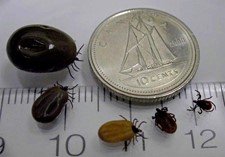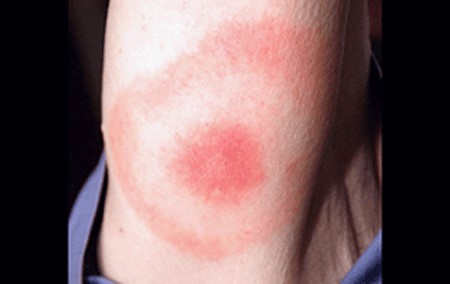Lyme disease is caused by a bite from Ixodes scapularis, a small, black-legged tick also called a deer tick. These ticks live in wooded, grassy areas and can be spread by birds and deer. Ticks attach to skin and feed on blood. They can bite at any time but are most active April to September. They inject bacteria called Borrelia burgdorferi into the skin 36 hours after the bite, so removing the tick before then can prevent Lyme disease. It is important to check your skin for ticks if you spend time outdoors. When caught early and treated, Lyme disease can be cured with antibiotics and most people recover fully.
If you develop any symptoms within a few weeks after a tick bite, such as a rash, fever or body aches, see your doctor.

Adult female tick that enlarges at various stages of feeding.
There are 3 stages of Lyme disease:
Stage 1: A quickly expanding bull’s-eye rash can develop at the site of the bite within days to weeks of being bitten. The area may be itchy or painful. 50% of infected people develop flu-like symptoms that may begin before the rash appears.

Bull’s eye rash.
Stage 2: About 1 to 2 months or longer after the bite, different rashes and symptoms may occur. Without treatment, the bacteria injected by the tick can spread to other areas of your body and can cause small rashes that typically appear on the face and extremities. Red bumps may also develop.
Some people feel ill with systemic symptoms such as fever, transient arthritis, headaches, muscles aches, neck stiffness, numbness or pain, shortness of breath, dizzy spells, and heart problems, such as chest pains or an irregular heartbeat.
If treated with antibiotics at this point, the symptoms tend to clear within three weeks. Without treatment, the symptoms tend to come and go indefinitely, and some people develop stage 3 Lyme disease.
Stage 3: This stage can occur months to years after the bite. Most problems occur in the heart and nervous system, and these can be serious. Symptoms may include problems remembering and concentrating, dementia, nerve pain, heart failure and arthritis.
Areas of the skin can become red and swollen and then begin to harden and shrink, causing deep lines to form. Even with treatment for Lyme disease at this stage, the changes to the skin and symptoms tend to be permanent.
Recommendations to prevent tick bites:
- Wear light-coloured clothing so it’s easier to see ticks. Wear closed-toed shoes, a long-sleeved shirt and tuck long pants into your socks.
- Walk in the center of trails and try to avoid brushy areas.
- Use insect repellent that contains 20 to 30 percent DEET on exposed skin and clothing.
- Examine your skin after spending time in wooded or grassy areas.
- Keep grass mowed short and trim bushes to allow light to enter which deters ticks.
- Check your pet’s skin.
- If you have new symptoms, call your healthcare provider to find out about follow-up care and possible testing of the tick for the Lyme disease bacteria.
Check your skin often for ticks:
- Shower after all outdoor activities are over for the day and run fingers gently over your skin to feel for any ticks.
- Visually examine your skin and all joints including behind the knees, between fingers and toes, and on underarms.
- Check other areas where ticks are commonly found such as the belly button, neck, hairline, top of the head, and in and behind the ears.
- Examine areas of pressure points, including anywhere that clothing presses tightly on the skin.
How to remove a tick:
- Use tweezers to remove the tick. Sterilize the tip of the tweezers using rubbing alcohol and grasp the tick as close to the skin’s surface as possible.
- Pull upward with steady, even pressure. Avoid twisting, squeezing or crushing the tick, as this can cause its head or mouth to break off and remain in your skin. If this happens, use tweezers to remove the remaining parts. If you cannot remove the rest of the tick, see your doctor.
- After removal, wash skin well with soap and water and apply an antiseptic cream.
- Dispose of the tick. You can either place it in a sealed bag or container, submerse it in alcohol, or wrap it tightly in tape. You may also want to save it in a sealed jar in case you develop any symptoms after the bite. The tick can then be tested for disease.
At Gidon Aesthetic & MediSpa in Toronto, we encourage you to enjoy the outdoors but be mindful and protect yourself.



